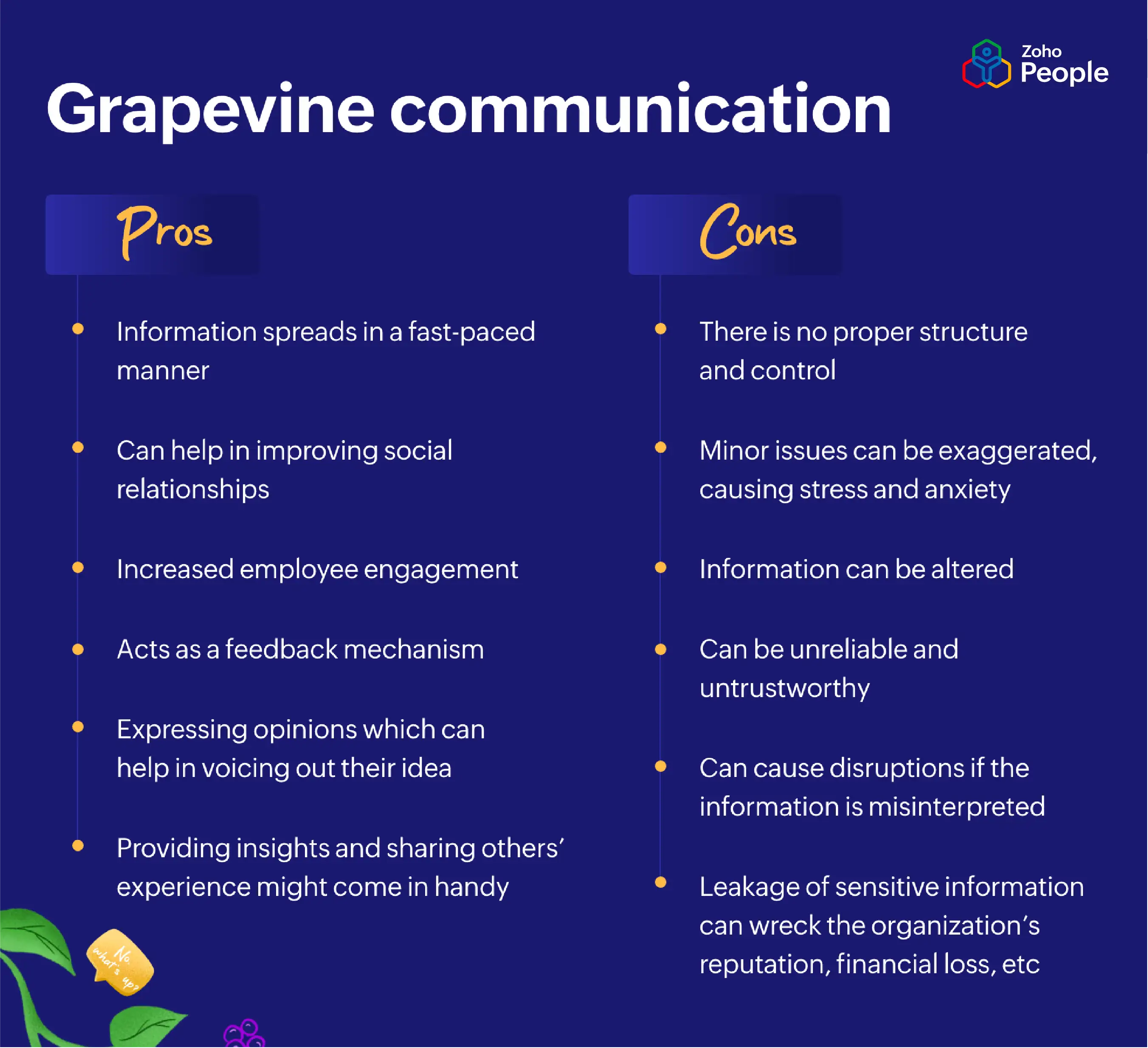- HOME
- More
- Employee Engagement
- Grapevine communication: What it means and how to handle it
Grapevine communication: What it means and how to handle it
- Last Updated : November 8, 2024
- 2.1K Views
- 4 Min Read

In every organization, from small scale businesses to large enterprises, communication plays a significant role in shaping the culture and building strong workforce relationships. One of the most common forms of information exchange in a workplace is grapevine communication. It can be both positive and negative, and that entirely depends on the situation.
What is grapevine communication?
Unlike its more formal counterparts, grapevine communication is an unofficial method of information sharing. It typically takes the form of rumors and gossip. When information is passed through the organization using grapevine communication, it is fast-paced, spontaneous, and often unreliable.
Why people engage in grapevine communication?
Employees rely on grapevine communication during casual social interactions, including when sharing workplace stories and experiences. It's a quick way to convey information to coworkers and express related sentiments. Engaging in gossip can sometimes be a coping mechanism, depending on the workplace environment.
Let's look more closely at the key reasons why people participate in grapevine communication.
Filling information gaps
One of the primary reasons why people engage in grapevine communication is the fear of missing out, or FOMO. In some cases, formal communication about specific updates or events can be vague, so employees seek additional information through unofficial channels. This is where grapevine communication can come in handy. Discussions about projects or changes in the organization can be done informally and quickly, making it easier for employees to understand key details. It also allows people to brainstorm among themselves and come up with creative solutions to workplace problems. Grapevine communication can enhance employee awareness by filling in such gaps.
Influencing others' opinions
People tend to voice their perspective in informal conversations. In critical situations, sharing experiences and insights through grapevine communication can be beneficial. For instance, employees who are facing the same problems feel less alone when exchanging experiences, opinions, and suggestions. Expressing their views in informal discussions can give coworkers the support and motivation they need to face difficult conditions.
In other cases, grapevine communication can be used to manipulate workplace opinions and spread one-sided information. Sometimes, employees with a personal agenda exploit the informal channels to manipulate others' beliefs or undermine certain decisions. This may cause misunderstandings and conflicts within the organization.
Coping mechanism
In times of uncertainty or change, employees may cope with anxiety by sharing rumors. Doing so can help them feel more connected to the issues and give them insights into their organization's choices. Sharing concerns with peers can also stimulate a sense of support, which can in turn improve the sense of belonging and reduce stress.
Pros and cons of grapevine communication
There are many advantages and disadvantages of grapevine communication. Its positive aspects include improved camaraderie, fast-paced information exchange, and greater chances for valuable insights that the formal channel may not be able to capture. Employees use grapevine communication to develop workplace relationships, exchange ideas, and stay updated on organizational changes.
Associated disadvantages include risks of misinformation, distortion, lack of structure and control, and rumors that could destroy trust and create confusion. Understanding the different advantages and disadvantages of grapevine communication helps an organization effectively communicate.
How to handle grapevine communication and build a positive work culture?
Cultivating a culture of open communication
Encouraging transparent communication is essential for managing grapevine communication effectively. Providing accurate and timely information through formal channels helps reduce reliance on informal sources. Creating an environment where open communication is welcomed allows employees to voice their opinions and concerns freely, fostering a culture of inclusivity and collaboration.
Addressing rumors promptly
Develop a strategic approach to rumor management, as this is critical to sustaining trust and preventing the spread of misinformation. Address and clarify the rumors as soon as possible. Encourage your employees to fact-check information before forwarding it. Set up a system that employees can use to report rumors so that timely intervention and correction are possible.
Fostering trust and inclusion
Implement trust-building initiatives that promote transparency, accountability, and fairness within the organization. Creating a healthy work culture where all employees feel valued and respected reduces the chances of people starting rumors. Engage leaders in order to develop relationships while promoting trust in organizational leadership.
Encouraging positive use of informal channels
Use grapevine communication for positive discussions that can bond colleagues and create a sense of innovation. The informal channels may involve some team-building activities and social gatherings that strengthen relationships. Recognize and appreciate employees who contribute positively through informal communication, reinforcing the value of constructive interactions.
Wrapping up
Organizations that recognize grapevine communication and manage it strategically can use it to improve employee engagement and build trust. By encouraging transparency, listening to employee issues, and developing a positive workforce culture, organizations can minimize the distortion caused by unproductive gossip. Understanding grapevine communication and using it to everyone's advantage makes for a more bonded and resilient workplace.



